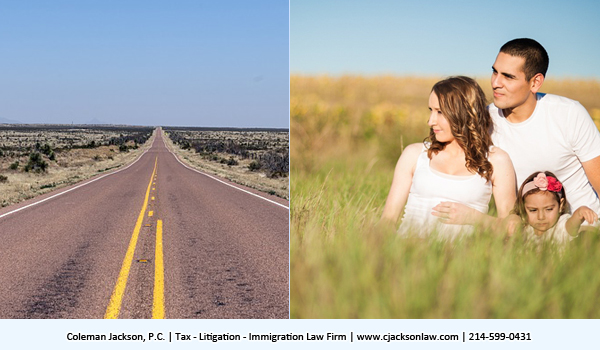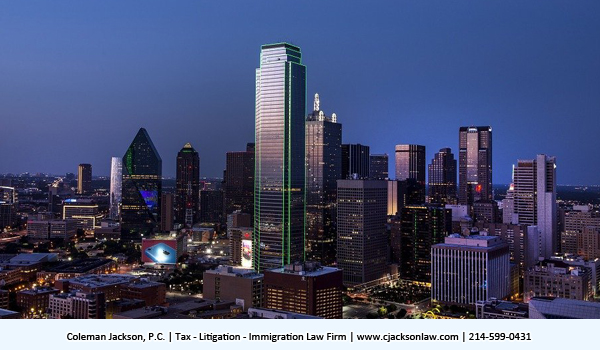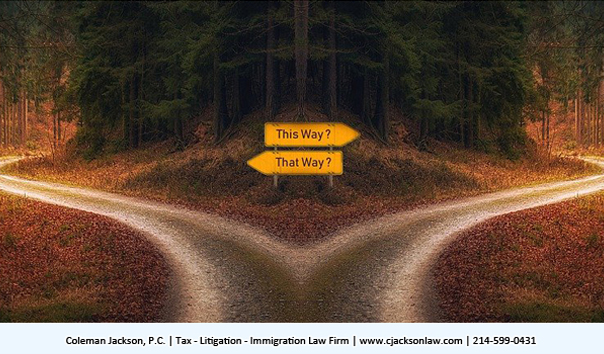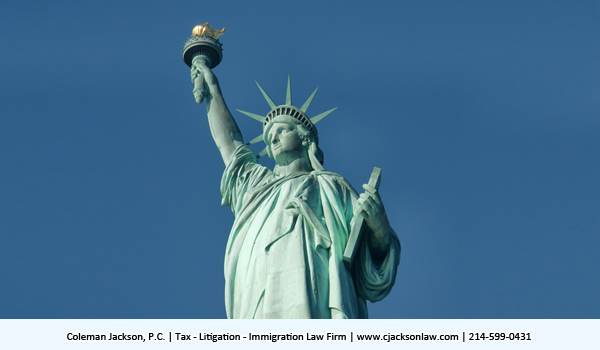By: Coleman Jackson, Attorney & Certified Public Accountant
October 20, 2020
General Overview of the EB-5 Investor Visa: The fifth employment-based preference for immigrant investors is codified in 8 U.S. Code. The fundamental purpose of the EB-5 Investor Visa Program was enacted by Congress to grow or spur economic growth within the United States. The fifth employment-based preference visa is designed to afford foreign investors the opportunity to live and raise their families in the U.S. in return for building a new commercial for-profit enterprise or invest in an existing U.S. for-profit enterprise employing up to ten additional full-time employees. The statute sets forth strict guidelines as to what constitutes an at-risk investment, what constitutes a commercial enterprise and what constitutes employment of full-time employees. Again, in return for the investment the principal foreign investor, their spouse and children (under 21 years of age) could reside in the United States, attend school in the United States, work in the United States, and apply for citizenship and retire in the United States.
In a nutshell: The EB-5 Investor’s Visa category is aimed at qualified wealthy foreigners seeking to obtain permanent legal residence in the United States, investing in a new for-profit commercial enterprise that will benefit the United States economy and create at least 10 full-time jobs in the United States per investor. The program is currently administered by USCIS. The investment required per EB-5 investor is currently $1.8 million, although this limit is reduced to $900,000 if the investment is made in a rural community or high unemployment area, known as a Target Employment Area (TEA). These minimum EB-5 Visa investment amounts came into force in 2019. On November 21, 2019, the EB-5 Program underwent its first major change since the program began in 1990. In July 2019, the Department of Homeland Security published changes to the EB-5 Investor Visa Program in the Federal Register. The modifications or changes were named, “EB-5 Modernization Regulations for the Immigrant Investor Program (regulations)”. The new regulations increased the minimum investment amount from $1,5 million to $1.8 million and to $900,000 from $500,000 in a TEA designated area. Moreover, the regulations switched the TEA designation authority or designation decision making process from the individual states and gave it exclusively to the USCIS. The policy aim given for making these regulation changes to the EB-5 implementation regulations was to get back to the true Congressional intent for enacting the immigration statute in the first place; that is, the goal was to grow the U.S. economy and create American jobs through foreign investors investing substantial at-risk capital in return for a clear path to U.S. citizenship.
EB-5 Method and Processing:
Foreign investors can take one or two Paths to make the required at-risk capital investment. One Path is for the foreigner to establish a new commercial enterprise or invest into an existing for-profit enterprise by creating or joining a sole proprietorship, limited liability company, partnership, corporation or some other form of for-profit enterprise already organized and operating within the United States. If the foreign investor takes this first prong of the stand-alone enterprise path by creating a business that complies with the statute; they must have or employ the skills and expertise to run an entrepreneur type business or startup company. The second prong of the stand-alone path is for the foreign investor to invest a going concern that is already organized and established in the United States. The Regional Center path is another way that the foreign investor can participate in the EB-5 visa program. This is alternative path is the investment path that many foreign investors take in making an EB-5 investment. Regardless of whether the investor create an enterprise or invest capital in a Regional Center, the enterprise must be a for-profit business; it must be in business to make a profit. The enterprise cannot be non-profit enterprise. There is a sequence of steps in the EB-5 immigration process for an EB-5 investor to earn a permanent green card. In the event the EB-5 investor selects to invest the required capital in a Regional Center approved by the USCIS, the EB-5 participant files an I-526 petition requesting conditional residency. USCIS and the State Department will determine whether the EB-5 participant qualifies for the conditional EB-5 visa. Due diligence during this part of the process includes a detailed review of the EB-5 investor’s sources of funds, family history and other representations concerning the EB-5 investor, his spouse and qualified unmarried children under the age of 21. The petition also includes a complete description of the EB-5 investment and any economic models, proforma financials, and personnel budgeting used to determine job creation. If approved, the EB-5 investor requests a conditional green card through an interview at the consulate or a status adjustment (if he or she is already in the US on another visa). If approved, the EB-5 investor receives a conditional green card valid for two years. In the final 90 days of the two-year conditional residency period, investor EB-5 files petition I-829 to remove conditions from the green card. This petition demonstrates that the EB-5 investor’s capital was fully invested and at risk during the two-year period and that the 10 necessary skilled jobs were created. Upon approval of petition I-829, the EB-5 investor and his qualified family members become legal permanent residents and may, ultimately, choose to become US citizens after five years.
Steps on the EB-5 Regional Center Path: 
- First Due Diligence: The potential EB-5 investor requests information about the CMB Regional Centers and the current EB-5 offerings. As soon as a confidentiality agreement is signed, the prospective EB-5 investor receives the Private Placement Memorandum, Subscription Agreement, Limited Partnership Agreement and Warranty Agreement. The foreign investor must do its due diligence in selecting a qualified, proven, and USCIS authorized Regional Center. Due diligence requires careful examination of the structure of the Regional Center and its management, financials, projects, success stories and overall reputation.
- EB-5 investor chooses CMB: The EB-5 investor executes the signature documents and returns them to the CMB. The EB-5 investor then transfers his registration fee to a custody account established by the partnership on behalf of the investor where the funds are held by the custodian bank. The release of funds from the deposit may only occur in accordance with the terms of the Guarantee Agreement. The CMB Administrative Placement Agent reviews the EB-5 investor’s subscription for suitability and compliance with securities laws. Once processed, the EB-5 investor is formally accepted as a limited partner in the partnership.
- Petition I-526: Once the EB-5 investor is accepted as a limited partner in a CMB EB-5 partnership, the investor’s immigration attorney files petition I-526 with USCIS.
- Consulate Interview: If petition I-526 is approved, the EB-5 investor requests a conditional green card through an interview at the consulate or a status adjustment (Form I-485), if he or she is already in the US on another visa. If petition I-526 is denied, the investor’s capital contribution would be returned to the partner in accordance with the terms of the articles of association.
- Conditional Permanent Residence: Once the EB-5 investor is approved for a visa and a visa is available, the investor and qualified family members receive conditional green cards that are valid for two years. The EB-5 investor must enter the United States within 180 days, if not already in the United States. This entry into the United States begins the period of 24 months of conditional permanent residence.
- Petition I-829: Between the months 22-24 of the EB-5 investor’s conditional permanent residency period, the investor’s immigration attorney files petition I-829 to remove the conditions from the green card and be able to receive his ten-year green card.
- Return on Capital: Once all investments in the partnership have been repaid, the limited partners can vote to settle the partnership and distribute the balance of each capital account in accordance with the Partnership Agreement. The foreign investor must be sure to understand the terms and conditions of the Regional Center with regards to return of capital and all other financial terms and practices of the Regional Center.
Processing time: On average 24 months for you to get the temporary green card that is valid for 2 years, where you must apply for a new permanent visa. After that, the government will evaluate two things: if the capital was really invested in the project and at least ten jobs were generated in that time. If the investor meets the requirements, the investor receives the permanent visa in a few months.
Steps on the EB-5 Stand-Alone Business Path: 
- First Decide How To Structure the Enterprise:As I said before, when the foreign investor chooses to build a stand-alone business, the immigrant can choose between investing in a business that already exists in the USA, an option chosen by the vast majority of foreign investors, or by creating the business itself from the ground-up, which requires a larger number of documents and takes more time and entrepreneur skills on the part of the foreign investor; its management team and outside attorneys, accountants, bankers, risk management professionals, realtors and other expertise. The amount of the minimum investments does not change, whether the investor buy into an existing enterprise or structure an enterprise from scratch. The foreign EB-5 Visa investor will need to invest$1.8 million in at-risk capital into the business. This amount is reduced to $ 900,000 if the EB-5 project is located in a Target Employment Area (TEA). To be designated as a TEA, the EB-5 project must be located in a rural area or in a location that has high unemployment. The designation of a Target Employment Area is requested through petition I-526 from investor EB-5’s. And remember the TEA designation is now being made exclusively by USCIS. The states no longer are authorized under the 2019 Regulations to make TEA determinations.
- What does the term TEA mean: A high TEA unemployment rate is defined in the statute as a location or area with an unemployment rate of at least 150% of the U.S. national average. A TEA area could be located in the middle of a major metropolitan area if the unemployment rate meets or exceeds this threshold. However, the area with high unemployment should be located in a municipality or metropolitan area that has a population of 20,000 or more. An EB-5 project may be designated TEA if the main location of the project is located in an area of high unemployment at the time the EB-5 investment is made. The following resources might be helpful in acquiring sufficient evidence for the TEA designation:
- The US National Bureau of Statistics (US Bureau of Labor Statistic) Office of Local Unemployment Statistics (LAUS) in recent published technical bulletins;
- Letters from federal, state and local public agencies presenting evidence of a rural or high unemployment area;
- Other statistical documentation, such as Census data
- Stand-Alone Enterprise Path Processing:The processing steps 3, 4, 5, 6 and 7 that applies to the Regional Center Path that I discussed above also applies to the Stand-Alone Business Path if the foreign investor chooses to take the stand-alone business Path rather than investing in a USCIS approved Regional Center. These particular steps are primarily the same; except, for the involvement of an USCIS approved Regional Center and the particulars related to that.
Substantive Requirements of all EB-5 Foreign Investors Regardless of the Investment Path: 
- The interested investor must first of all prove the legality of the funds. This is a critical requirement and the investor must be able prove the chain-of-ownership and chain-of-possession of all of the at-risk-capital.
- According to USCIS, the EB-5 investment must preserve or create a minimum of 10 full-time positions for workers in the United States who qualify. Such job creation or preservation must occur within two years of the investor’s conditional permanent residency and entry into the United States. Jobs created in EB-5 projects are defined as direct, indirect or induced. In the context of direct investment, the EB-5 visa applicant must prove that the EB-5 capital resulted in updating direct jobs for employees who work directly in the business in which the investment was made. In the context of the regional center, the candidate can count on direct, indirect and induced jobs in relation to the job creation requirement.
- Investing in a company: Foreign investors must engage in due diligence as to who is involved when investing, what they are investing in, where they are investing and why they are investing their capital. Due diligence is a must do exercise in EB-5 investing. Proving the legality of the investor’s income is just the beginning of the due diligence process. In the event, the interested foreign investor chooses to invest in an existing company, the investor should look for those that are licensed to receive funds under the EB-5 visa program. Some American developments that provide EB-5 investor opportunities are enterprises in engaged in such activities as resorts, luxury condominiums, restaurants, shopping centers, among others types of enterprises. The foreign investor could also decide to open and operate a startup from scratch. Where to invest depend upon the investor’s goals and objectives.
- Investing in a Regional Center Project: Here, the required investment in the approved Regional Center may be less and the number of jobs required to be generated or created are affected by the pooling of the investment of several foreign investors. Perhaps there is strength in numbers. But investment decisions must be made by individual investors taking all due diligence measures when counseling with professionals that are properly registered, licensed and controlled by the securities regulators and debt regulators in the United States.
Regulation Changes Implemented in 2019 and Some Impacts:
The new rules of the EB-5 visa program were implemented by DHS on November 21, 2019 and the highlights of the changes were as follows:
- Increase of the investment value from $1,000,000 to $1,800,000 in any area within the American territory, and from $500,000 to$900,000 in less privileged areas – those known as Targeted Employment Areas – TEA. It also established that the values will be revised every 05 years based on inflation: The change was established by the US Congress, with the objective of making a monetary correction and equalization with the same type of visa in other countries, since the previous value was the same since the visa was conceived in 1990. In addition, the objective was to match the other visas of investors in other countries such as Portugal, which is 1 million euros, in the United Kingdom it is 2 million of pounds.
- The designation of Targeted Employment Areas – TEA has come to be through the combination of continuous and adjacent registered areas in which the new commercial company is conducting and developing its business. These areas are expected to have high levels of unemployment – 150% above the national average, and should be cities and municipalities with populations over 20,000 inhabitants, and which are outside the areas of large metropolises. The United States Department of Homeland Security-DHS will decide who determines whether a certain area is classified as a TEA, eliminating the participation of state agencies. Therefore, the administration of the process and tasks such as receiving investment requests and determining areas of economic stress passed from the state to the federal level, through the Department of Homeland Security, which makes the process a little longer. This is because the local authority has a great interest in making this financial contribution to their area, where acceptance of the investment took about a month. Moving to the federal level, it may take a little longer.
- The beneficiaries of the main applicant may individually submit the last form I-829 of the EB5 visa process that transforms the permanent resident card from provisional to permanent. If there are problems with the visa transformation of the main applicant, the dependents can individually submit the last form.
- The fourth change is regarding direct EB-5. Until then, the investor of the program through direct investment had to open his own business and actively manage it to comply with the rules of generating the 10 jobs required for a minimum period of 2 years. With this change, the investor will not need to directly manage the business. The mere fact of being a rights holder through a limited partnership contract model or a participation in a new company incorporated through a limited company will meet the requirements of the active participation program in the new commercial company.
According to the United States Department of Homeland Security – DHS, the recent changes in the regulation of the EB-5 foreign investor visa program were implemented in order to combat harmful practices that were being manipulated by some operators of the program due to loopholes and flaws in its regulations.
One of the harmful practices to which they refer to is the inclusion of areas of large cities as being less privileged within the American territory, the well-known Targeted Employment Areas – TEA.
The U.S. government immigration agency announced on January 29, 2020 a change to the EB-5 visa, which gives foreigners who invest in the country the right to permanent residence. The change will be in the queue for analysis of visa investment processes, which will give priority to requests from Brazilians as of March 31, 2020. Today, the processes of all nationalities are analyzed in a general queue in the order of entry, with the response time for Brazilians between 35 to 40 months. With the measure, a single queue for each country will be created, and the deadline should fall significantly.
The processes will begin to analyze the requests from countries that do not have their quotas already occupied, such as Brazil. This change in the criteria will potentially favor, a lot, Brazilians who intend to come as investors in the EB-5 visa for the United States. The case being analyzed and answered faster will most likely lead to faster green card processing, that is, a life with less stress in the United States without the traditional anxiety about waiting and waiting for the process to work.
In 2018, Brazil was the American country that accounted for the most emissions from the EB-5 visa, also known as “Golden Visa”. There were 388 green cards awarded to Brazilians who want to invest and live in the USA. The increase was 37.5% compared to 2017 and 1,041.2% compared to 2015. In 2019, worldwide, Brazil ranked 6th among countries with the largest number of participants in the EB-5 program, becoming the country with the highest number of emissions on the American continent.
The intention of this program is to benefit local workers, boost the economy and help communities in need, attracting foreign capital investment in the United States. The EB-5 is still the most considerable path for those who want to get a green card. It is highly sought after by those who want to not only live in the USA, but invest and have a thriving business.
Historical Profile of those applying for the EB-5 foreign investor’s visa:
 Internationally, the application for this type of visa historically has been led by Chinese, but the number of Brazilians has grown steadily in recent years. The applications appear to be from Brazilians; generally speaking, who are entrepreneurs and people of considerable wealth who no longer want to live in Brazil. From 2012 to 2018, there was an increase of more than 15 times in demand. In 2012, 24 Brazilians applied for the EB-5 foreign investor’s visa. Until 2015, it was stable, with 34 applications. Then, with the crisis in Brazil, it increased: 150 in 2016, 282 in 2017 and finally 388 in 2018.
Internationally, the application for this type of visa historically has been led by Chinese, but the number of Brazilians has grown steadily in recent years. The applications appear to be from Brazilians; generally speaking, who are entrepreneurs and people of considerable wealth who no longer want to live in Brazil. From 2012 to 2018, there was an increase of more than 15 times in demand. In 2012, 24 Brazilians applied for the EB-5 foreign investor’s visa. Until 2015, it was stable, with 34 applications. Then, with the crisis in Brazil, it increased: 150 in 2016, 282 in 2017 and finally 388 in 2018.
Potential Advantages of Becoming an EB-5 Foreign Investor: 
- Path to Green Card;
- Path to U.S. Citizenship;
- Path to Financial and Physical Security;
- Path to Reuniting with Family, Colleague and Friends who Have Already Moved to the United States;
- Path to Great Education and Schooling for the Entire Family;
- Path to building strong international businesses;
- Path to dream and give to the community
Follow our law firm’s blogs and listen to our Legal Thoughts Podcast on Apple Podcast, Google Podcast, Spotify or where ever you listen to your podcast for updates concerning these topics and other taxation, litigation and immigration information you can use!
This law blog is written by the Taxation | Litigation | Immigration Law Firm of Coleman Jackson, P.C. for educational purposes; it does not create an attorney-client relationship between this law firm and its reader. You should consult with legal counsel in your geographical area with respect to any legal issues impacting you, your family or business.
Coleman Jackson, P.C. | Taxation, Litigation, Immigration Law Firm | English (214) 599-0431 | Spanish (214) 599-0432 | Portuguese (214) 272-3100




